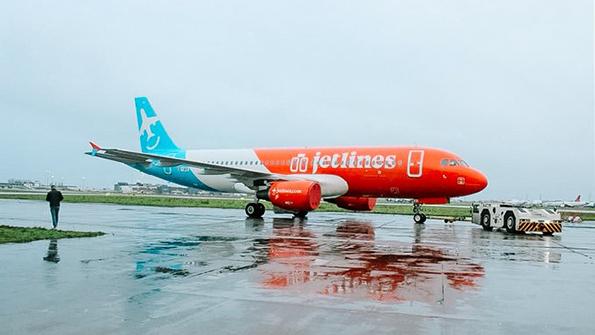
Two Canadian airlines that have been attempting to become airborne for years, Jetlines and Lynx, appear to be finally making their debut in 2022. But the odds of their success remain tough to predict.
Jetlines’ origins date back to at least late 2013, and the company has targeted numerous launch dates since. In 2014, it announced an order for five Boeing 737 MAX narrow-bodies. The company has also previously featured some seasoned low-cost veterans at its helm, including former AirTran Chief Financial Officer and Sun Country Airlines CEO Stan Gadek and Allegiant senior executive Lukas Johnson.
The airline has also altered its strategy throughout the years. At the time Jetlines planned to launch service in the summer of 2018, its network strategy was based on seasonal travel patterns in Canada, and the company named two secondary airports—Toronto Hamilton and Water-loo International—as its initial bases.
- New carriers hope to inject more competition into Canada’s low-cost sector
- Powerful incumbents will fiercely defend their turf
Jetlines is now targeting a launch early this year with Airbus A320ceos and projects growing its fleet to 15 aircraft by 2025 in an all-economy-class configuration.
The airline has previously billed itself as an ultra-low-cost carrier (ULCC), but its current marketing language is more vague. It will launch as a tour operator with flights to sunny destinations in the U.S. and Mexico.
The airline is also establishing Canada Jetlines Vacations and partnering with its former parent company, Global Crossing Airlines Group, to jointly market GlobalX Air Tours flights from Toronto’s Pearson International Airport to Miami and Fort Lauderdale for an eight-week period beginning in February. Once Jetlines gains the necessary regulatory approvals for launch, it will operate those routes with its own aircraft. It also plans to operate scheduled airline service.
Charter operator Enerjet has been working to establish a ULCC since the middle of the last decade, too, and has emerged with a new brand, Lynx. The airline is sticking with the ULCC business model and has firm orders and lease agreements for 46 737 MAX aircraft due to be delivered over the next seven years. Lynx expects to take delivery of three aircraft early this year. Its roster of executives includes CEO Merren McArthur, who has served as CEO of both Tigerair Australia and Virgin Australia Cargo. Its founder and chief operations officer is Tim Morgan, who also was a founder of WestJet.
Lynx will be based in Calgary, Alberta, home to Canada’s second-largest airline, WestJet. The startup, which has declared itself “Canada’s new ultra-affordable airline,” plans to make its debut in early April with the launch of service from Calgary to Vancouver. That will be followed by flights from Toronto to Vancouver and later from Calgary and Vancouver to Kelowna, British Columbia, and from Calgary to Winnipeg, Manitoba. Data from Aviation Week’s CAPA – Centre for Aviation show those routes are already well served. Air Canada and WestJet operate on all the pairings, and ULCC Flair also offers service on most of the routes, with the exception of Calgary and Vancouver to Kelowna.
Indeed, National Bank of Canada analyst Cameron Doerksen notes that multiple airlines already serve many destinations targeted by the startups in Canada and in the U.S.
Jetlines and Lynx are joining two established ULCCs operating in Canada: Flair and WestJet subsidiary Swoop. Flair is growing rapidly and recently outlined an ambitious fleet expansion to 20 Boeing narrowbodies, from 12, by this summer. Its vision is to have a fleet of 50 aircraft by 2025.
Porter Airlines is growing, too, slated to begin adding 30 Embraer 195-E2 aircraft to its fleet this year that it plans to deploy from Halifax, Nova Scotia, as well as Montreal, Ottawa and Toronto Pearson.
As Canada’s smaller airlines race to expand and capitalize on what they believe is pent-up demand, the obvious question is: Can the market support such rapid growth?
Doerksen notes that the country’s scheduled airlines have a fleet of 592 registered aircraft, which account for just under 100,000 seats. The stated expansion plans by Flair, Jetlines, Porter and Lynx would add nearly 30% more seat capacity over a multiyear period.
“It is not a realistic expectation for the industry to grow at that level,” Doerksen says. He also questions what other financial sources those startups have to execute those expansion strategies.
And although Canada’s large incumbent carriers—Air Canada and WestJet—have faced all the challenges other operators have endured during the COVID-19 pandemic, they remain well-capitalized and will no doubt compete fiercely against smaller airlines aiming to break into Canada’s aviation market. For example, Doerksen points to Air Canada’s C$10 billion ($8 billion ) in unrestricted liquidity.
He also fully expects Air Canada and WestJet to defend their market share. But even as they guard their turf, there is no shortage of ambition among Canadian startup airlines, which are finally seeing their aspirations come to fruition.





